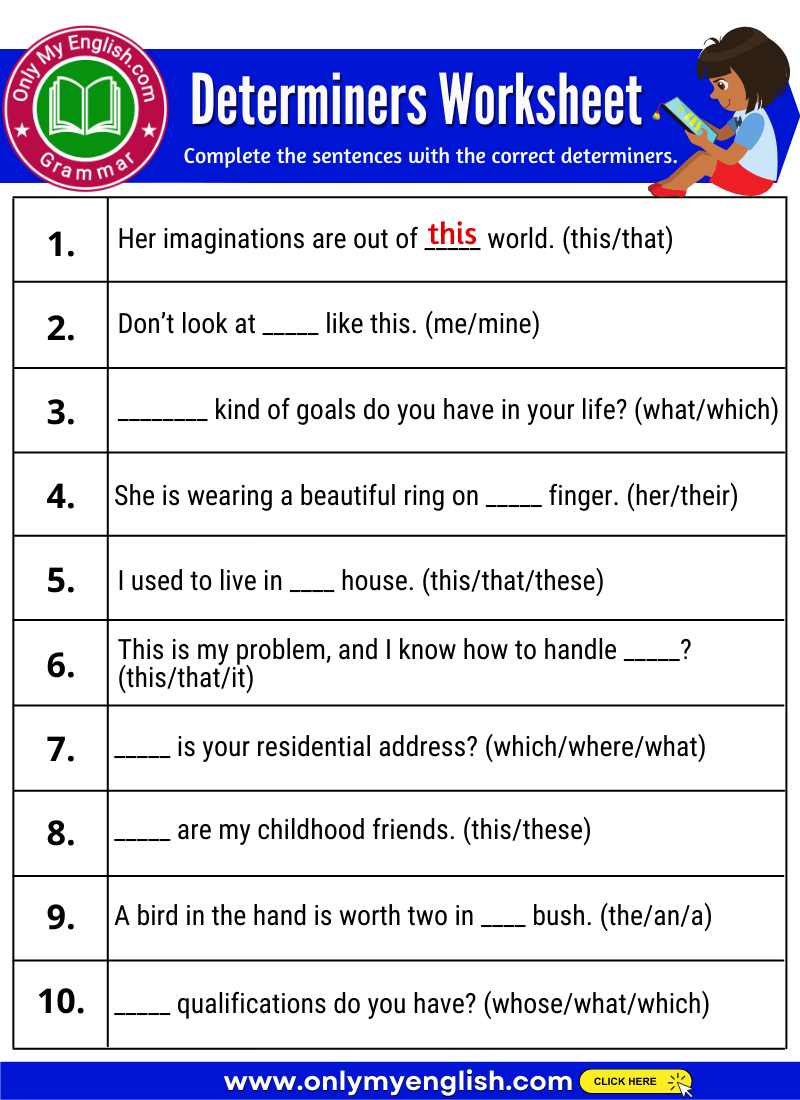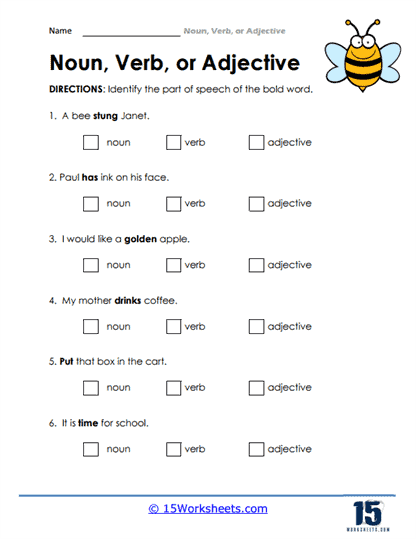
Navigating the Noun Phrase: The Essential Adjectives vs. Determiners Worksheet
The English language, with its rich tapestry of words and intricate grammatical rules, often presents learners with nuanced distinctions that can be challenging to master. Among these, the difference between adjectives and determiners is a perennial source of confusion. While both word classes modify nouns, their roles, placement, and fundamental functions are distinct. For students, educators, and language enthusiasts alike, a well-crafted adjectives vs. determiners worksheet is not just a helpful tool; it’s an indispensable guide to unlocking a deeper understanding of noun phrase construction and enhancing grammatical precision.
This comprehensive article will delve into the definitions, functions, and distinctions of adjectives and determiners, explore why they are frequently confused, and highlight the immense value of an effective adjectives vs. determiners worksheet in clarifying these critical grammatical concepts.
Adjectives: The Describers of Language

Adjectives are words that describe or modify nouns and pronouns. They provide more information about the noun’s qualities, characteristics, or states. Think of them as the artists of language, painting vivid pictures with words.

Key Characteristics of Adjectives:

- Descriptive Function: Their primary role is to answer questions like "What kind?", "Which one?", or "How many?" (when referring to a general quantity, not a specific count).

- Examples: Red car (What kind of car?), Tall building (What kind of building?), Beautiful sunset (What kind of sunset?).
- Placement:
- Attributive Adjectives: Most commonly, adjectives appear before the noun they modify.
- Examples: A fast car, the old house, happy children.

- Predicative Adjectives: They can also appear after a linking verb (like "is," "are," "seem," "feel," "become") and refer back to the subject.
- Examples: The car is fast. The house seems old. The children are happy.



- Attributive Adjectives: Most commonly, adjectives appear before the noun they modify.
- Comparability: Many adjectives have comparative and superlative forms to show degrees of quality.
- Examples: Big, bigger, biggest; beautiful, more beautiful, most beautiful.
- Open Class: Adjectives belong to an "open class" of words, meaning new adjectives are constantly being created and added to the language.

Types of Adjectives:
- Descriptive Adjectives: These are the most common type, describing qualities. (e.g., blue, soft, intelligent, quiet)
- Quantitative Adjectives: While some overlap with determiners, these refer to non-specific amounts. (e.g., many problems, few ideas, some water – when used to describe an amount without specifying which ones)
- Proper Adjectives: Derived from proper nouns, they are capitalized. (e.g., American history, Shakespearean plays)
- Compound Adjectives: Two or more words joined, often with a hyphen, to form a single adjective. (e.g., well-known author, long-term goal)
Determiners: The Specifiers and Introducers
Determiners are words that precede and introduce nouns, providing information about their reference. Unlike adjectives, which describe what kind of noun it is, determiners specify which noun or how much/many of it there is. They limit or clarify the noun’s meaning without describing its qualities.
Key Characteristics of Determiners:
- Specifying Function: Their primary role is to answer questions like "Which one?", "How many/much?", "Whose?", or simply to indicate that a noun is coming.
- Examples: The book (Which specific book?), Three apples (How many apples?), My car (Whose car?).
- Placement: Determiners always come before the noun they modify, and they always come first in a noun phrase, even before any adjectives.
- Examples: The old house, My red car, Some delicious cookies.
- Closed Class: Determiners belong to a "closed class" of words, meaning there’s a finite number of them, and new ones are rarely added.
- Non-comparable: Determiners do not have comparative or superlative forms. You can’t say "theer" or "myest."
Types of Determiners:
- Articles: The most common determiners.
- Definite Article: The (refers to a specific noun known to the speaker/listener).
- Indefinite Articles: A, An (refers to a non-specific or general noun).
- Demonstrative Determiners: Point to specific nouns.
- Examples: This, That, These, Those (e.g., This book, Those trees).
- Possessive Determiners: Indicate ownership or possession.
- Examples: My, Your, His, Her, Its, Our, Their (e.g., My phone, Their house).
- Quantifiers: Indicate quantity or amount.
- Examples: Some, Any, Many, Much, Few, Little, All, Both, Each, Every, No, Several (e.g., Many students, Little time, All people).
- Numbers (Cardinal & Ordinal):
- Examples: One, Two, Three…; First, Second, Third… (e.g., Two cats, The first time).
- Distributive Determiners: Refer to individual members of a group.
- Examples: Each, Every, Either, Neither (e.g., Each student, Every day).
- Interrogative Determiners: Used to ask questions about nouns.
- Examples: Which, What, Whose (e.g., Which book?, Whose car?).
The Overlap and Confusion: Why an Adjectives vs. Determiners Worksheet is Crucial
The main reason for confusion between adjectives and determiners lies in the fact that some words can function as both, or that their roles seem superficially similar. Words like "this," "that," "these," "those," "some," "any," "much," and "many" are prime culprits.
Consider these examples:
-
"This" as a Determiner vs. a Pronoun:
- Determiner: This book is mine. (Specifies which book)
- Pronoun: This is my book. (Stands alone, replaces a noun)
- Note: "This" generally does not function as an adjective in the descriptive sense. Its role is always specifying or referring. The confusion arises because it modifies a noun.
-
"My" as a Determiner vs. "Mine" as a Possessive Pronoun:
- Determiner: My car is fast. (Specifies whose car)
- Pronoun: That car is mine. (Stands alone, replaces "my car")
- Note: Possessive determiners (my, your, his, her, its, our, their) are often mistakenly called "possessive adjectives" because they modify nouns. However, grammatically, they function as determiners because they specify ownership rather than describe a quality. They belong to the closed class of determiners and always come first in the noun phrase.
-
"Some" as a Determiner vs. a Quantitative Adjective (less common distinction in this context):
- Determiner (Quantifier): I need some sugar. (Specifies an indefinite quantity, introduces the noun)
- Adjective (Descriptive): He was feeling some kind of way. (Here, "some" describes a vague quality, but this usage is less common and more idiomatic. In most quantity contexts, it’s a determiner.)
The Golden Rule for Distinction:
The most reliable way to differentiate is by asking:
- Does it describe a quality or characteristic of the noun? (e.g., red, tall, intelligent) -> Adjective
- Does it specify which noun, how much/many, or introduce the noun? (e.g., the, this, my, three, some) -> Determiner
And remember the order: Determiner + Adjective(s) + Noun
- Example: The big red car. (The = determiner, big = adjective, red = adjective, car = noun)
The Indispensable Role of an Adjectives vs. Determiners Worksheet
Given the subtleties and potential for confusion, a targeted adjectives vs. determiners worksheet becomes an invaluable educational tool. It provides a structured environment for learners to practice, identify, and solidify their understanding of these grammatical categories.
Why an Adjectives vs. Determiners Worksheet is Essential:
- Clarifies Nuances: It directly addresses the common points of confusion by presenting examples where the distinction is critical.
- Reinforces Learning: Repetitive practice, carefully designed, helps internalize the rules and exceptions.
- Develops Grammatical Accuracy: By correctly identifying and using these word classes, learners improve their sentence construction and overall grammatical correctness.
- Enhances Reading Comprehension: Understanding the role of determiners helps in accurately interpreting the reference of nouns in a text.
- Improves Writing Clarity: Precise use of determiners and adjectives makes writing more coherent, specific, and engaging.
- Prepares for Standardized Tests: Many English proficiency exams and academic assessments include questions testing the correct usage and identification of these parts of speech.
- Benefits ESL/EFL Learners: Non-native speakers often struggle with these distinctions, as their first language might have different structures. A dedicated adjectives vs. determiners worksheet offers focused practice.
- Fosters Analytical Skills: Students learn to critically analyze sentences and identify the function of each word, a skill transferable to other areas of language learning.
Designing an Effective Adjectives vs. Determiners Worksheet
An effective adjectives vs. determiners worksheet should be varied, clear, and progressively challenging. Here are some exercise types and considerations:
- Identification Exercises:
- Provide sentences and ask students to underline or highlight all adjectives in one color and all determiners in another.
- Example: "The small dog chased its tail."
- Categorization Tables:
- Give a list of words and ask students to place them into "Adjective" or "Determiner" columns. Include words that are commonly confused.
- Example Words: red, the, beautiful, this, three, some, happy, my, every, old.
- Fill-in-the-Blanks:
- Provide sentences with blanks and a word bank (or allow free choice) for students to insert appropriate adjectives or determiners.
- Example: " (determiner) cat is chasing a (adjective) mouse."
- Sentence Construction:
- Ask students to write sentences using specific adjectives and determiners, demonstrating their understanding of placement.
- Example: "Write a sentence using ‘many’ as a determiner and ‘delicious’ as an adjective."
- Error Correction:
- Present sentences with incorrect usage or placement of adjectives/determiners and ask students to correct them.
- Example: "My a car is old." (Correction: A car is old / My car is old.)
- Transformation Exercises:
- Ask students to rewrite sentences, changing an adjective to a determiner (if possible, though less direct) or vice versa, or adding both.
- Example: "The house is old." -> "The old house is mine."
- Contextual Analysis:
- Provide short paragraphs and ask students to analyze the role of specific words based on their context. This is crucial for words that can function differently.
- Answer Key: Always include a clear answer key for self-assessment and feedback.
- Gradual Difficulty: Start with simpler sentences and clear-cut examples, then introduce more complex structures and ambiguous cases.
- Real-World Examples: Use sentences that are relatable and reflect natural language use to make the learning more engaging.
Conclusion
The distinction between adjectives and determiners is more than just a dry grammatical rule; it’s fundamental to constructing clear, precise, and meaningful English sentences. Adjectives enrich our descriptions, while determiners provide essential specificity and context for nouns. While their roles can sometimes appear to overlap, a firm grasp of their individual functions is paramount for language mastery.
An adjectives vs. determiners worksheet serves as a vital pedagogical tool, offering the focused practice necessary to demystify these concepts. By diligently working through such exercises, learners can confidently navigate the complexities of noun phrases, sharpen their analytical skills, and ultimately enhance their overall proficiency in the English language. Embracing the challenge of these distinctions is a significant step towards becoming a more articulate and grammatically adept communicator.
